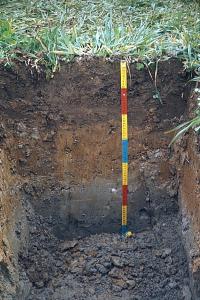Reference soil Germany 06: Gleysol
Gleysols occur throughout the world where groundwater comes near to the surface, causing soils to become wet for a prolonged part of the year. They are particularly abundant in the low-lying river basins.
Characteristics
Soils having gleyic properties (properties associated with prolonged wetness) within 50 cm from the soil surface. They have no diagnostic horizons other than an anthraquic, histic, mollic, ochric, takyric, or umbric horizon at the surface, or an andic, calcic, cambic, gypsic, plinthic, salic, sulfuric, or vitric horizon within 100 cm from the soil surface.
A typic example of a gley soil with pronounced oxidation resp. reduction horizon. Below 40 cm the profile is gravelly. The Bg horizon has 2 colours (7,5YR 5/6 and 2,5Y 6/2). There is common organic matter in the Ap horizons. Besides, some very coarse dead plant roots can be found in the lowest horizon. The groundwater level has been lowered artificially. Parent material consists of alluvial deposits, maily derived from adjacent loess deposits. (additional climatic data Aachen: insolation (hrs))
|
WRB 2006: |
WRB 1998: |
||||||||||||
|
|
||||||||||||
|
|
|
FAO-UNESCO-ISRIC 1988: |
FAO-UNESCO 1974: |
||||||||||||
|
|
||||||||||||
|
|
Other classification
|
Classification (other) |
Typischer Gley |
Nordrhein-Westphalen, 6km SE of Jülich in the valley of the Ellebach
